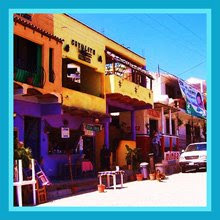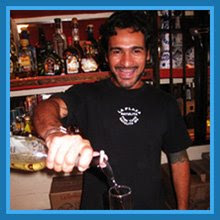 My good friend Ed Schwartz is the kind of guy you want to sit and have a drink with. Luckily our friendship allows this and more. He is a long time Wine industry rep and enthusiast, and has now turned his attention to what Mexican's call "vino", our dear Tequila. Ed and his wife Bambi have become great friends and my son Maximo's 3rd set of grandparents, and are now locals in our town of Sayulita, Mexico. Ed is the PR guy for the S.F.T. Tequila Bar where I am often found, and has recently wrote a great story for the Nob Hill Gazette about Tequila, it's history, and a wonderful tasting we did with Mark at the Bar. Here is an excerpt (the picture above is Ed and I at my U.S. Citizenship ceremony in California last month):
My good friend Ed Schwartz is the kind of guy you want to sit and have a drink with. Luckily our friendship allows this and more. He is a long time Wine industry rep and enthusiast, and has now turned his attention to what Mexican's call "vino", our dear Tequila. Ed and his wife Bambi have become great friends and my son Maximo's 3rd set of grandparents, and are now locals in our town of Sayulita, Mexico. Ed is the PR guy for the S.F.T. Tequila Bar where I am often found, and has recently wrote a great story for the Nob Hill Gazette about Tequila, it's history, and a wonderful tasting we did with Mark at the Bar. Here is an excerpt (the picture above is Ed and I at my U.S. Citizenship ceremony in California last month):
Tequila—The Town & The Tastes
by Ed Schwartz
Tequila, Jalisco, Mexico—One hour west of Guadalajara, we are in tequila country, anchored by the town of Tequila. As we make the turn off Highway 15 and into this charming place, we are greeted by rows and rows of proud, blue agave plants, their spiky crowns pointing to the bright, hot sun. Once in the town, there is much to see, including a beautiful church, the new and tranquil José Cuervo visitors’ center, and, no surprise, dozens and dozens of shops selling a wide range of tequilas, the national spirit of Mexico.
The highlight of our visit was the beautiful tequila museum, which tells the history of the spirit in pictures, art, rare bottles, and ancient barrels and production equipment.
The process of making tequila is long and difficult. It begins when the blue agave plant (Agave Tequiliana Weber Azul) is ripe—usually when it’s eight years or older. The leaves are chopped away with great effort by an expert jimador; what is left is a very large bottom core. These cores are called piñas (pineapples, which they resemble) and can weigh from forty to two-hundred pounds. There are 136 species of agave, of which blue agave is just one.
There are many types of tequila; there are also very strict rules about what can be called tequila. By Mexican law, a spirit can only be called a tequila if it is made in the state of Jalisco and is comprised of no less than fifty-one percent blue agave.
The best tequilas are those that are one-hundred percent blue agave; they come in three types: blanco (also called plata or silver), reposado, and añejo. Other tequilas, which feature a lesser percentage of blue agave, come in blanco, oro, reposado, and añejo. Blanco is the traditional tequila, clear and strong. Gold (oro) tequila is mellowed by colorants and flavorings and is generally used in the wildly popular margarita cocktail, now the best-selling cocktail in the U.S. Reposado (rested) means that the spirit has rested in oak for two months to one year. Añejo, old, is aged for up to eight years; older tequilas can be called extra añejo.
Use of the agave plant—called maguey—has a long history in Mexico. Centuries before the Spanish conquest of Mexico, indigenous people were making an alcoholic drink from fermented agave called pulque. When the Spanish came, they distilled this brew into a more intense spirit. And, the leaves of the agave were used to make mats, clothing, rope, and a type of paper.
As time went by, many of the best of the distilled spirits were made in the state of Jalisco and eventually dubbed tequila. Agave spirits made elsewhere, and utilizing other species of agave, are commonly referred to as mezcal (a common phrase in the Mexican spirits world is “all tequilas are mezcals, but not all mezcals are tequila”). Additionally, just as Jalisco has done with tequila, other areas have dubbed their mezcal with a name to identify it with the region. For instance, in Sonora it’s bacanora and in Chihuahua it’s sotol.
A common misconception (which makes for a good bar bet, certain to win you a drink or two) is that agave is a cactus; it’s not. The agave is a succulent, related to the lily and amaryllis family.
Sales of tequila are hot, hot, hot (as are, increasingly, sales of mezcal), especially at the luxury end, where bottles start at $50. Case sales in the U.S. are around eleven million annually.
But all is not joy in the tequila industry. Ironically, the independent blue agave farmers are up against it financially. It is very hard to make a living when the grower gets only one crop every eight years or so and receives so little money for it. So, many are turning to where the “green” is, tearing out picturesque agave fields and planting corn for ethanol. Obviously, this is not good for the long-term health of the industry.
But there is joy in the present. Our little town of Sayulita, just north of Puerto Vallarta, is a mecca for tequila lovers thanks to the Sayulita Fish Taco Tequila Bar, on the town square. Here, tequila maven and good host Mark Alberto Holt has created a cozy and welcoming all-tequila bar next to the famous fish taco restaurant he owns with his wife. Mark has 220 tempting tequilas as well as vast knowledge of the spirit. Here are eight of his favorites, which he served to mi amigo and man about town Gabriel Villarrubia and me, Pancho Schwartz.
Don Fernando Tequila Blanco—Double distilled. Starts off with a peppery nose; it’s clean and spicy with lots of complexity.
Don Eduardo Blanco—Subtle nose, but full and excellent taste. The pepper overtone is there but in thoughtful balance.
Corzo Tequila Reposado—Fine nose with a rich, complex taste; mellow throughout and a fine, long finish.
Clase Azul Reposado—This spirit comes in a large, blue, hand-painted porcelain bottle, and the tequila lives up to its fancy encapsulation. Almost a shy nose, but rich and full with sweet caramel notes and nice hints of lemon.
Don Julio 1942 Añejo—A superior expression with a sweetness and smoothness much resembling a very fine cognac. My choice of the group.
Don Fulano Añejo—Well aged, but retains its refreshing, peppery taste.
Casa Noble Añejo Special Reserve—Dark, brooding, rich, and warm; it shows its five years of wood aging in the taste. Very limited production.
Tres, Cuarto, y Cinco—Comes in a beautiful hand-blown glass bottle about eighteen inches high. Very rich, amber color; a huge taste with very assertive wood notes.
Ed Schwartz has been involved in many aspects of fine wine for 30 years and has worked with top wineries in California, Italy and France. His writings on wine, food and travel have appeared in the SF Chronicle, LA Times and Image magazine. His website is www.edschwartzpr.com









0 comments:
Post a Comment